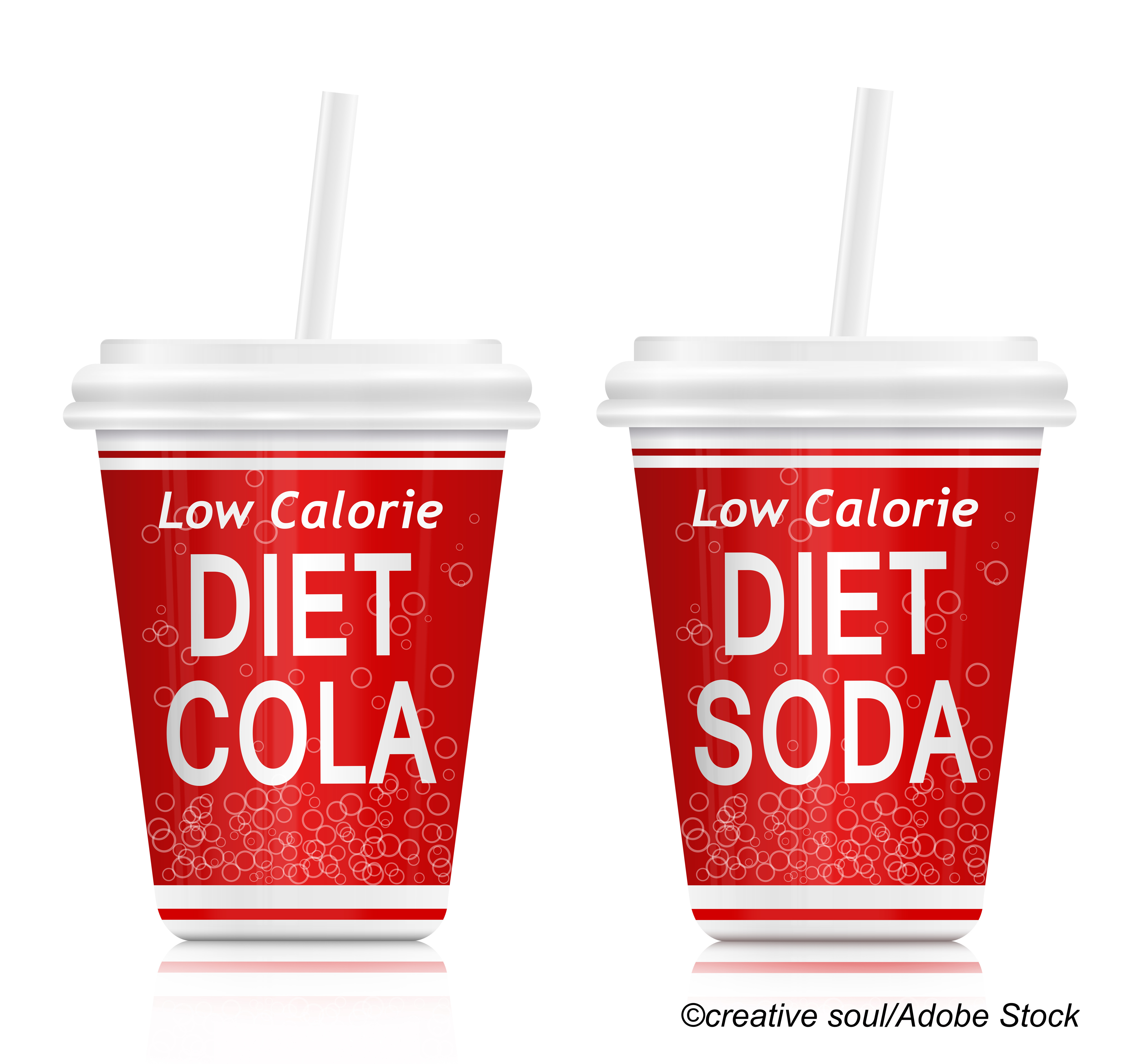Diet drinks and other foods with non-nutritive sweeteners (NNS) may not be helpful for people trying to lose weight. In fact, they may undermine a weight-loss diet. A randomized trial found that neural responses, metabolic profile, and eating behavior differed after consuming the NNS sucralose versus the nutritive sugar sucrose.
Interactions between body mass index (BMI) and sweetener consumed were seen for reactivity in the medial frontal cortex (MFC; P for interaction<0.001) and orbitofrontal cortex (OFC; P for interaction=0.002) on functional MRI (fMRI), reported Kathleen Page, MD, of the University of Southern California, Los Angeles, and co-authors.
People with BMI-defined obesity—but not overweight or healthy weight people — had greater responsivity to savory versus nonfood visual food cues after sucralose versus sucrose consumption (MFC β 0.60, 95% CI 0.38 to 0.83; P<0.001, and OFC β 0.27, 95% CI 0.11 to 0.43; P=0.002), they wrote in JAMA Network Open.
Sucrose consumption was associated with greater plasma values of glucose, insulin, and glucagon-like peptide-1 and suppression of acyl-ghrelin, but no differences in peptide YY or leptin. Sucralose consumption was not associated with changes in these metabolites.
Moreover, female participants consumed greater total calories (β 1.73 95% CI 0.38-3.08; P=0.01) at a free-range buffet meal after consuming sucralose versus sucrose, but caloric intake did not differ in males. No interaction was seen for BMI status on sweetener consumed with respect to total buffet calories.
“These findings suggest that female individuals and those with obesity may be particularly sensitive to disparate neural responsivity elicited by sucralose compared with sucrose consumption,” Page and colleagues wrote.
“Of note, both the MFC and OFC are regions of the brain implicated in mediating conditioned motivation to eat and encoding reward value or valence of food cues, and obesity has been shown to be associated with greater food cue reactivity within these prefrontal reward-related areas,” they added.
The randomized, within-participant crossover trial included 74 participants; 58% were women and mean age was about 23. BMI ranged from 19-40 with 37% of participants at a healthy weight, 32% overweight, and 31% obese.
Participants were drawn from the Brain Response to Sugar parent trial population. All were non-smokers with stable weight for at least 3 months who were not dieting, not taking medication, and had no history of eating disorders, illicit drug use, or medical diagnoses.
On three visits, participants consumed a 300-ml sweetness-matched drink with sucrose or sucralose, or water as a control. At about 125 minutes after sweetener consumption, they dined at a calorie-quantified free-range buffet. In the interval, fMRI was obtained to see responses to pictures of non-food versus food with food divided into low- and high-calorie images, and high-calorie food images further divided into sweet and savory.
Metabolic changes were studied with plasma values of the energy-related metabolites glucose, insulin, glucagon-like peptide (7-36), acyl-ghrelin, total peptide YY, and leptin, sampled at baseline and 10, 35, and 120 minutes after sweetener consumption.
Primary outcomes evaluated fMRI signal changes, indicating increased blood flow and an inferred increase in metabolic activity, in specific brain areas that included insula, hippocampus, striatum, and other areas, in addition to the MFC and OFC.
Females had increased MFC response for high- versus low-calorie visual cues (β 0.21, 95% CI 0.05-0.37; P=0.01) and for sweet versus nonfood cues (β 0.22, 95% CI 0.02-0.42; P=0.03). They also had increased OFC response for food versus nonfood cues (β 0.12, 95% CI 0.02-0.22; P=0.03) and for sweet versus nonfood cues (β 0.15, 95% CI 0.03-0.27; P=0.01).
Post-hoc analysis considered contributions to fMRI signal changes among the six possible BMI-sex combinations for the savory versus nonfood comparison.
Female participants with obesity contributed disproportionately to the three-way interaction among BMI status, sex, and drink condition on MFC response to savory versus nonfood cues, Page and colleagues observed. “Differences were not found in other subgroups,” they wrote.
“The study by Page and colleagues is of great importance as it provides novel insights into how adiposity and sex are associated with neural and behavioral outcomes of NNS ingestion,” noted Stephanie Kullmann, PhD, of University of Tübingen in Germany, in an accompanying editorial.
“They show for the first time that female individuals with obesity are particularly vulnerable to greater neural responsivity elicited by acute sucralose consumption, particularly in prefrontal reward-associated brain regions,” she wrote. “This raises the possibility that adding NNSs to our diet to increase sweetness could impair the brain’s responsivity to food, with negative consequences for eating behavior and metabolism, particularly in women.”
A recent study suggested that short-term daily consumption of sucralose can alter neural and metabolic sensitivity to sugar when consumed with carbohydrates, Kullmann pointed out. “Hence, in addition to the individual biological factors discussed by Page et al, neurobehavioral and metabolic consequences of NNS ingestion may also depend on how they are consumed,” she noted.
Before recommending or discouraging the use of NNSs, further studies on a variety of neurobehavioral and metabolic outcomes are warranted, Kullmann added. “The study by Page et al clearly points out the importance of considering sex and adiposity in future research to give individual tailored dietary recommendations for body weight management,” she wrote.
Limitations of the study included the possibility that NNSs other than sucralose may cause different effects on neuroendocrine regulation of appetite and eating behavior. Different patterns of carbohydrate consumption dose and timing with respect to NNS consumption may modify the results seen in the trial.
-
Neural responses, metabolic profile, and eating behavior differed after consuming the non-nutritive sweetener (NNS) sucralose versus the nutritive sugar sucrose, a randomized trial found.
-
Females and people with obesity may be particularly sensitive to the disparate neural responsivity between sucralose and sucrose.
Paul Smyth, MD, Contributing Writer, BreakingMED™
This work was supported by the NIH National Institute of Diabetes and Digestive and Kidney Diseases.
Page had no disclosures.
Kullmann had no disclosures.
Cat ID: 795
Topic ID: 76,795,730,795,130,51,518,94,917,925



